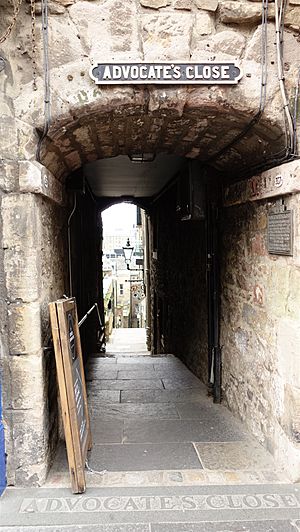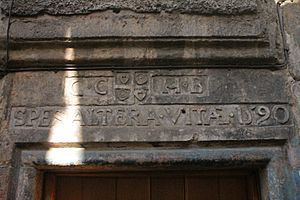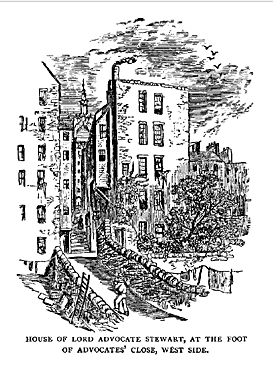Advocates Close facts for kids
Advocates Close is a cool, narrow, and steep alley in Edinburgh. It's really old, going back to medieval times! It has lots of steps, so it's not easy for everyone to use.
This alley connects Market Street to the famous Royal Mile. It comes out right across from St Giles Cathedral, near the Supreme Court of Scotland. If you stand at the top of the close on the Royal Mile, you get an amazing view. You can see the tall and beautiful Scott Monument framed perfectly!
Contents
History of the Close
This street has been around since at least the 1400s. Some parts of the buildings are even from the mid-1500s! Back then, it was a very fancy place to live. Important Scottish families and professionals lived here with their servants.
The name "Advocates Close" comes from the house of Sir James Stewart. He was a very important lawyer called the Lord Advocate of Scotland. Another important house belonged to Adam Bothwell. It was on the west side of the close.
Changes Over Time
By the 1800s, many rich families moved out of Edinburgh's Old Town. They went to newer, more modern parts of the city. Places like Advocates Close became homes for many working-class families. The buildings were split into smaller apartments called tenements.
Because so many people lived in a small area, and the streets were dark and narrow, the area became very crowded. There wasn't a good system for waste, so things could get quite messy.
One big building in the 1800s was the Imperial Hotel. It was built where the Lord Advocate's house used to be. Later, this spot became offices for the Edinburgh Evening News newspaper. After that, it was the main office for the Edinburgh Festival.
Modern Views and Changes
Some buildings from the 1500s are still standing on the east side of the close. In the 1920s, many buildings on the west side were taken down. This was part of a plan to improve crowded areas.
When they removed buildings, they saved some old carved doorways. They moved these doorways together, but they are now just for show. This demolition also opened up a new view of the Scott Monument.
A special bronze sign was added at the top of the close in 1935. It was put there by the city's architect, Ebenezer James MacRae.
Interest in Advocates Close grew again in 1993. A new group focused on saving the Old Town chose to put their office here. They picked the oldest building at the top of the close on the east side. This building was carefully fixed up. Workers found a large fireplace from the 1500s inside. They also found some old painted ceilings! This building had lost its top two floors in the 1920s.
Famous People Who Lived Here
- Andrew Crosbie (a lawyer)
- Sir James Stewart (Lord Advocate)
- David Dalrymple, Lord Westhall
- Adam Bothwell (son of Francis Bothwell)
- John Scougal (an artist)
Images for kids





